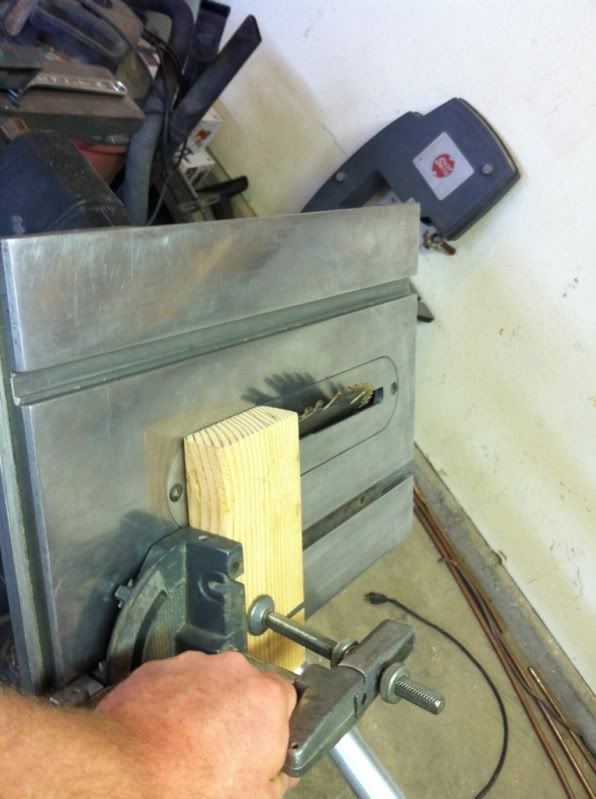Page 2 of 2
Posted: Tue Apr 26, 2011 3:03 pm
by gat_76
Just my luck. After putting on washers. Now saw is off parallel, .0027
Should be ok for the blade I have on there, but I do have a thin kerf blade.
In you guys' woodworking experience, would you say that's too much. Seems like it would hit the body of blade...
???
Posted: Tue Apr 26, 2011 3:19 pm
by gat_76
Yeah, table needs to be way more parallel to blade. It kinda cuts a bevel now, but barely, when tilted at 45, the miter slots are off by 1/16.
i guess that answers my above question.
Thanks again jpg and everyone for the help.
Posted: Tue Apr 26, 2011 3:22 pm
by JPG
Food for thought!
Have you determined the floor is 'level? Is it flat?
Have you determined the 'levelness of the trunion pivots?
Are the way tubes 'level' end to end? Front to back?
Point being level is irrelevant! Blade parallel to table miter slots is the 'square to blade' adjustment that needs to be corrected.
It is the planes(flat) that the table and saw blade define and their intersection that determines the 'squareness' to each other.
Posted: Tue Apr 26, 2011 3:24 pm
by pennview
Gat_76, perhaps if you posted a photo of how you have the saw set up when you're trying to make the cut and another photo that shows the wood where it gets stuck and starts to burn, we might be able to help. Take the photos with the saw unplugged.
Also are you saying that the blade stops turning when the burning of the wood takes place, or is it that you can't move the wood forward through the cut when the burning takes place and the blade is still spinning and causing the burning?
As it stands now, I'm thoroughly confused about what your problem is. If you can crosscut a piece of wood without a problem when the table is horizontal, then you should also be able to cross cut a piece of wood when the table is tilted.
A couple of comments about the relationship between the blade and the saw table:
- the blade needs to be perpendicular to the table.
- the blade needs to be parallel to the miter gauge slots in the table.
- the blade needs to be perpendicular to the face of the miter gauge.
With these three conditions met, you will cross cut wood squarely. Then, if you tilt the table, you will simply bevel the end of the stock being cut.
In addition, if the rip fence is parallel to the blade, you will rip a board squarely.
If your saw isn't set up this way, you'll have problems.
Posted: Tue Apr 26, 2011 3:28 pm
by JPG
BTW use those levels as a straight edge to adjust that table FLAT by shimming those mounting bolts. Remove all 'shimming' washers and start over. You should not need shims anywhere near approaching what you showed in your pix. Keep the thick one between the screw head and the table mounting 'slots'.
Good Luck!
Posted: Tue Apr 26, 2011 3:49 pm
by gat_76


That's where it just stops sawing. Spins, but won't cut.
Posted: Tue Apr 26, 2011 3:55 pm
by gat_76
Re adjusted table before thy try. Now, when tilted, .0036 off. Better, but no better cut. At this point, vertical squareness does not matter because that would just make the bevel angle off, still cut fine though. Right?
Posted: Tue Apr 26, 2011 4:01 pm
by gat_76
Thanks for the help. I'm learning a ton everyday.
I put a carbide, 40t, thin kerf blade on there. It was like butter. Beautiful 45 bevel.
I feel dumb when it's soo simple. I guess I need more experience to tell when a blade is dull.
Goofy called it.
Posted: Tue Apr 26, 2011 4:43 pm
by BigSky
gat_76 wrote:Thanks for the help. I'm learning a ton everyday.
I put a carbide, 40t, thin kerf blade on there. It was like butter. Beautiful 45 bevel.
I feel dumb when it's soo simple. I guess I need more experience to tell when a blade is dull.
Goofy called it.
Does this mean that you CAN cut a bevel and that the problem was really a dull blade?
It seems as though you have it figured but
this thread might help.

